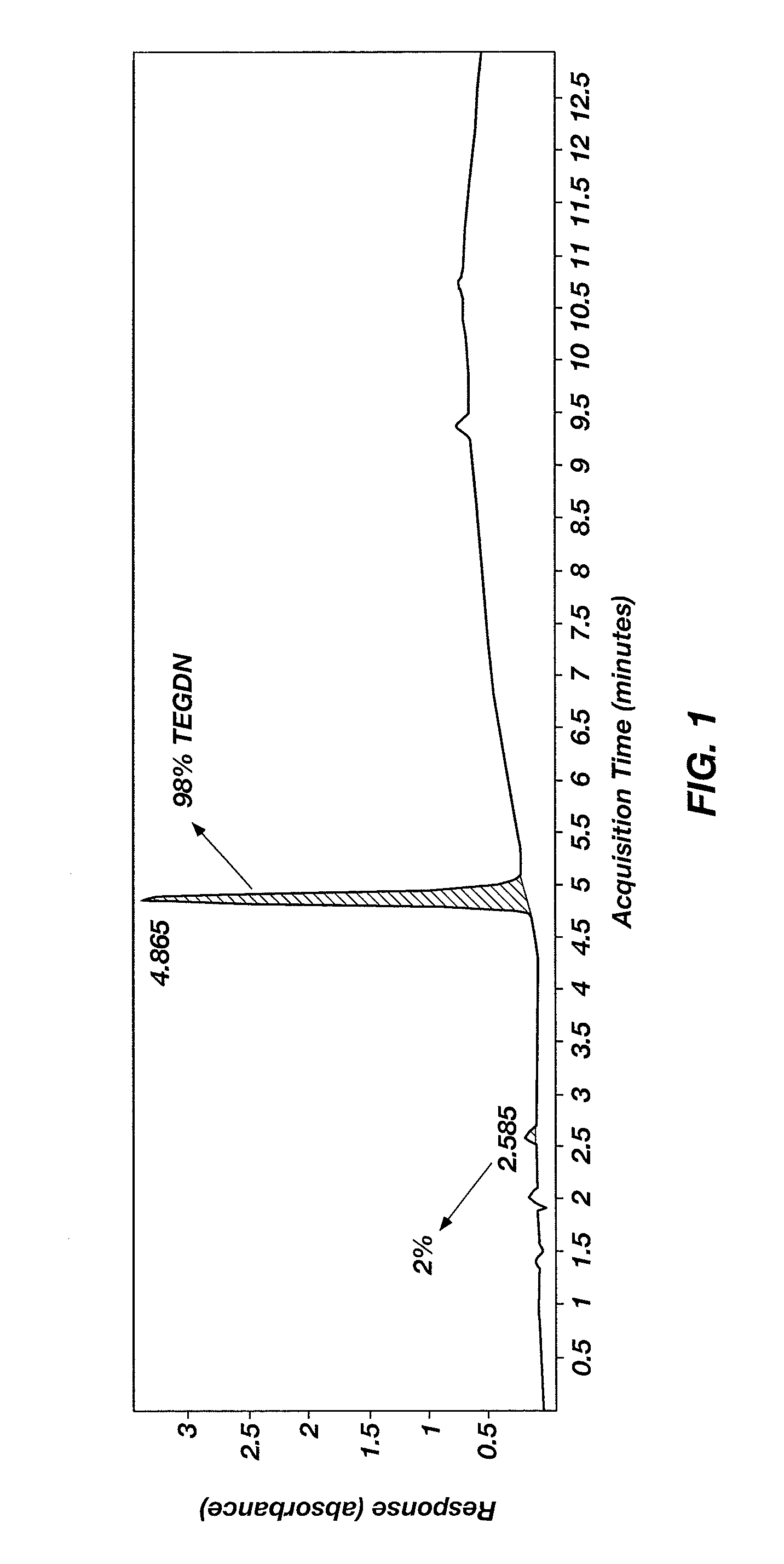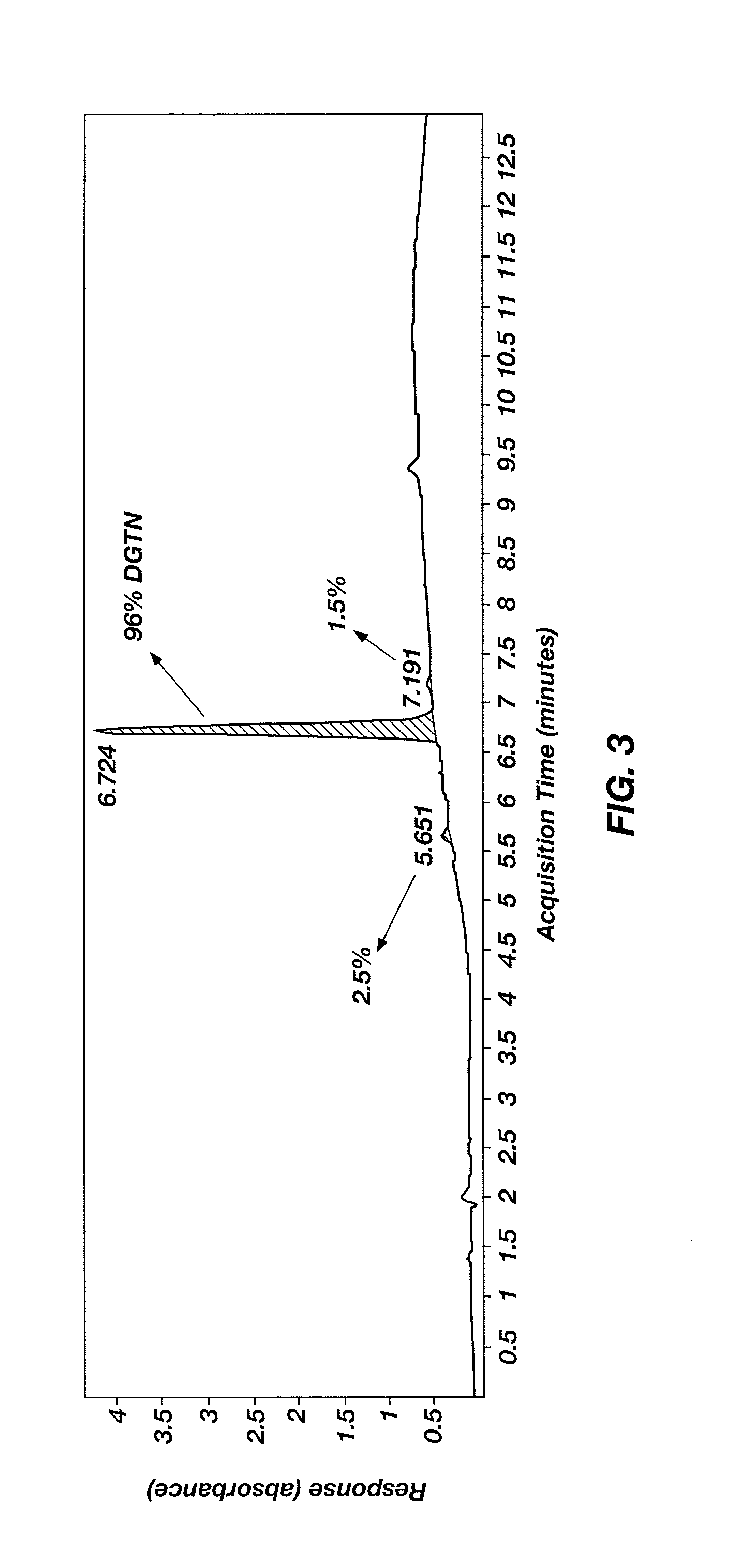Methods of producing nitrate esters
a technology of nitrate ester and nitrate ester, which is applied in the field of nitrate ester synthesis, can solve the problems of violent oxidative fume-off, mixed acid nitration reaction, poor separation of nitrate ester,
- Summary
- Abstract
- Description
- Claims
- Application Information
AI Technical Summary
Benefits of technology
Problems solved by technology
Method used
Image
Examples
example 1
Nitration of Triethylene Glycol (TEG) to Form Triethylene Glycol Dinitrate (TEGDN)
[0028]A round-bottom flask was charged with a magnetic stir bar and 10 mL of sulfuric acid, and then chilled in an ice bath. Ammonium nitrate (4.8 g (60 mmol)) was added at a rate such that the temperature of the nitrating solution did not exceed 20° C. TEG (2 mL (15 mmol), 99% purity, purchased from Sigma-Aldrich Co.) was added at a rate such that the temperature of the reaction mixture did not exceed 20° C. Once all the TEG was added and the temperature of the reaction mixture began to decrease, the ice bath was removed and the reaction mixture was stirred for 2 hours at ambient conditions. The reaction mixture was added in one portion to 50 g crushed ice and stirred gently until all the ice melted. The resulting emulsion was transferred to a separatory funnel and extracted three times with 20 mL methylene chloride. The combined organic extracts were dried with MgSO4 and then concentrated to produce ...
example 2
Nitration of Pentaerythritol to Form Pentaerythritol Tetranitrate (PETN)
[0031]A round-bottom flask was charged with a magnetic stir bar and 10 mL of sulfuric acid, and then chilled in an ice bath. Ammonium nitrate (2.36 g (29.4 mmol)) was added at a rate such that the temperature of the nitrating solution did not exceed 15° C. Pentaerythritol (0.5 g (3.7 mmol), ≧99% purity, purchased from Sigma-Aldrich Co.) was added in a single portion, with no notable exotherm. The ice bath was removed and the reaction mixture was stirred for 2 hours at ambient conditions. The reaction mixture was added in one portion to 50 g crushed ice and stirred gently until all the ice melted. The resulting precipitate was separated by filtration, rinsed with cold water, and air dried to produce PETN as a white solid (0.72 g of PETN, a 62% yield). The reaction is shown below:
[0032]
[0033]The PETN was characterized by 1H and 13C NMR spectroscopy and HPLC. As shown in FIG. 2, the PETN was about 94% pure. The 1H ...
example 3
Nitration of Diglycerol to Form Diglycerol Tetranitrate (DGTN)
[0034]A round-bottom flask was charged with a magnetic stir bar and 10 mL of sulfuric acid, and then chilled in an ice bath. Ammonium nitrate (3.85 g (48.1 mmol)) was added at a rate such that the temperature of the nitrating solution did not exceed 15° C. Diglycerol (1.0 g (6.01 mmol), >90% purity, purchased from Solvay Solexis, Inc.) was added at a rate such that the temperature of the reaction mixture did not exceed 15° C. Once all the diglycerol was added and the temperature of the reaction mixture began to decrease, the ice bath was removed and the reaction mixture was stirred for 1.5 hours at ambient conditions. The reaction mixture was added in one portion to 50 g crushed ice and stirred gently until all the ice melted. The resulting emulsion was transferred to a separatory funnel and extracted three times with 25 mL methylene chloride. The combined organic extracts were dried with MgSO4 and then concentrated to pr...
PUM
| Property | Measurement | Unit |
|---|---|---|
| temperature | aaaaa | aaaaa |
| temperature | aaaaa | aaaaa |
| temperature | aaaaa | aaaaa |
Abstract
Description
Claims
Application Information
 Login to View More
Login to View More - R&D
- Intellectual Property
- Life Sciences
- Materials
- Tech Scout
- Unparalleled Data Quality
- Higher Quality Content
- 60% Fewer Hallucinations
Browse by: Latest US Patents, China's latest patents, Technical Efficacy Thesaurus, Application Domain, Technology Topic, Popular Technical Reports.
© 2025 PatSnap. All rights reserved.Legal|Privacy policy|Modern Slavery Act Transparency Statement|Sitemap|About US| Contact US: help@patsnap.com



